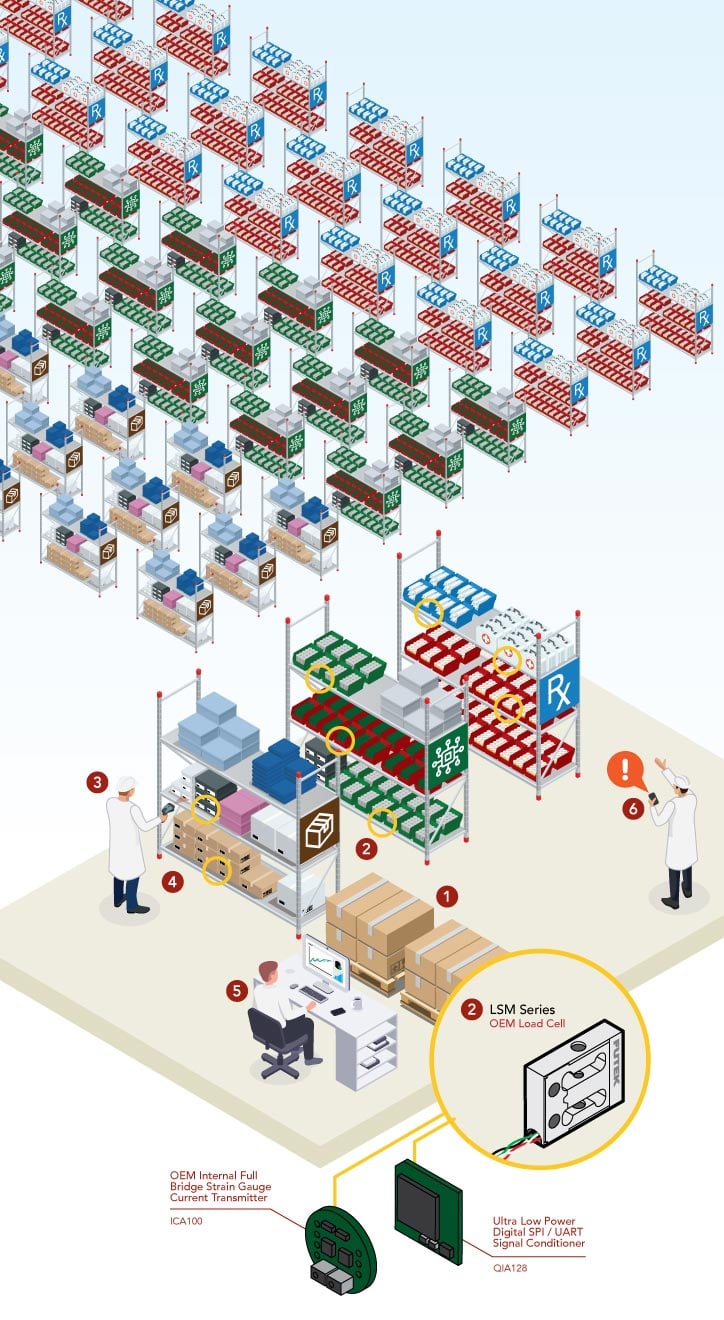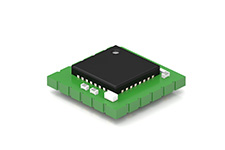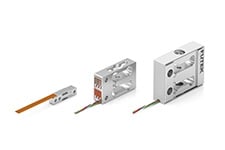What is weight-based inventory management?
In high-stakes sectors like aerospace, medical devices, and critical process industries, even minor inventory discrepancies can cause delays, compromise output, or violate regulations, making real-time, high-fidelity tracking mission-critical.
Weight-based inventory management addresses this need by using precision force measurement systems—such as industrial-grade load cells—to continuously monitor material stock. By replacing manual counts and barcode scans with metrologically sound, automated readings, this method delivers accurate, real-time visibility, reduces human error and supports compliant, closed-loop inventory control.
What are the benefits of this technology for large inventory management?
In large warehouses with hundreds of shelves and thousands of bins, real-time inventory monitoring is labor-intensive, costly, and prone to error. The key advantage of weight-based inventory systems is their ability to provide real-time visibility into inventory levels, enabling warehouse managers to optimize production planning, automate re-ordering, improve stocking efficiency, reduce inventory carrying costs and stockouts.
How does weight-based inventory management work?
Precision weight sensors such as FUTEK’s LSM series of load cells are installed under bins of components and integrated with the inventory management system (IMS) software. The IMS converts bin weight data into real-time inventory, triggering automatic replenishment orders when necessary. This eliminates manual inventory checks and reduces stockouts with minimal labor input.
Which industries benefit most from this technology?
Weight-based inventory management is particularly valuable in industries where precise handling of materials is necessary.
In the pharmaceutical industry, weight-based inventory management is used to measure and monitor weight of active pharmaceutical ingredients (APIs) and excipients. APIs and excipients are often handled in small quantities, making accurate measurement critical for ensuring compliance and product safety.
Similarly, in chip manufacturing, weight based inventory management is used to monitor the weight of delicate silicon wafers, to ensure precise handling and minimize waste.
Why are precision load cells well-suited for weight-based inventory management?
Load cells are transducers that convert weight into an electrical signal. This signal can be processed and used to calculate the weight of an item being measured. FUTEK’s LSM Series is a family of compact, high-precision load cells featuring built-in overload protection. The unique overload stop design protects the sensor from accidental damage during installation. The high accuracy and resolution of LSM load cells is ideal for inventory management, where even small measurement errors can cause significant discrepancies in inventory levels, disrupting the entire supply chain.
How it Works
Modern and large warehouse are challenged daily by the sheer amount of incoming and outgoing materials. Keeping precise track of the inventory count in a timely manner is a challenge for every business and supply chain manager.
Once the weight drops below the set minimum threshold, the Inventory Management System automatically sends a replenishment order to the distributor's ERP system, with the order quantity up to the maximum capacity of the bin.
FUTEK’s LSM Series load sensors are mounted under the bins on a stationary rack or mobile cart to weigh the parts at user-defined intervals. The weight sensors are connected to either an analog or a digital signal conditioner. It allows the mV/V sensor of the weight sensor to be connected to a data acquisition system (DAQ) or PLC.
Upon receiving the order, the distributor fulfills it by shipping the parts to the facility. The vendor or customer can then restock the bins with the received parts.
Inventory operators constantly retrieve items from the inventory to meet sales, production, and supply chain needs. In large inventories with hundreds of shelves and thousands of bins, holding millions of SKUs, the precise and real-time control of inventory count is a labor-intensive, costly and error-prone task.
Contact Us
Please Contact Us with questions.
What is weight-based inventory management?
In high-stakes sectors like aerospace, medical devices, and critical process industries, even minor inventory discrepancies can cause delays, compromise output, or violate regulations, making real-time, high-fidelity tracking mission-critical.
Weight-based inventory management addresses this need by using precision force measurement systems—such as industrial-grade load cells—to continuously monitor material stock. By replacing manual counts and barcode scans with metrologically sound, automated readings, this method delivers accurate, real-time visibility, reduces human error and supports compliant, closed-loop inventory control.
What are the benefits of this technology for large inventory management?
In large warehouses with hundreds of shelves and thousands of bins, real-time inventory monitoring is labor-intensive, costly, and prone to error. The key advantage of weight-based inventory systems is their ability to provide real-time visibility into inventory levels, enabling warehouse managers to optimize production planning, automate re-ordering, improve stocking efficiency, reduce inventory carrying costs and stockouts.
How does weight-based inventory management work?
Precision weight sensors such as FUTEK’s LSM series of load cells are installed under bins of components and integrated with the inventory management system (IMS) software. The IMS converts bin weight data into real-time inventory, triggering automatic replenishment orders when necessary. This eliminates manual inventory checks and reduces stockouts with minimal labor input.
Which industries benefit most from this technology?
Weight-based inventory management is particularly valuable in industries where precise handling of materials is necessary.
In the pharmaceutical industry, weight-based inventory management is used to measure and monitor weight of active pharmaceutical ingredients (APIs) and excipients. APIs and excipients are often handled in small quantities, making accurate measurement critical for ensuring compliance and product safety.
Similarly, in chip manufacturing, weight based inventory management is used to monitor the weight of delicate silicon wafers, to ensure precise handling and minimize waste.
Why are precision load cells well-suited for weight-based inventory management?
Load cells are transducers that convert weight into an electrical signal. This signal can be processed and used to calculate the weight of an item being measured. FUTEK’s LSM Series is a family of compact, high-precision load cells featuring built-in overload protection. The unique overload stop design protects the sensor from accidental damage during installation. The high accuracy and resolution of LSM load cells is ideal for inventory management, where even small measurement errors can cause significant discrepancies in inventory levels, disrupting the entire supply chain.


